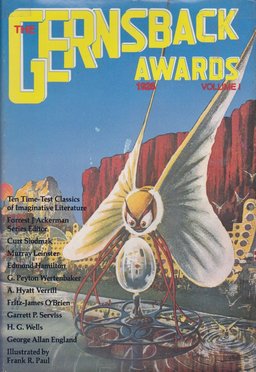Experience the Best Science Fiction of 1926 with The Gernsback Awards, Volume One
 The Hugo Award, science fiction’s most famous prize, was first dreamed up in 1953 for the 11th World Science Fiction Convention, and they’ve been given out every year since 1955. The prestigious Nebula, awarded by the Science Fiction and Fantasy Writers of America (SFWA), was first given out in 1966.
The Hugo Award, science fiction’s most famous prize, was first dreamed up in 1953 for the 11th World Science Fiction Convention, and they’ve been given out every year since 1955. The prestigious Nebula, awarded by the Science Fiction and Fantasy Writers of America (SFWA), was first given out in 1966.
Now, I know what you’re thinking. “But wait! What about all the marvelous science fiction and fantasy published between 1926, the year that marks the birth of Amazing Stories and hence science fiction as a genre, and 1953? With no prestigious award to draw the attention of future generations, is all that pulp fiction doomed to obscurity? Can nothing be done?!?”
Admit it — that’s exactly what you thought, over-punctuation and all. You should think about switching to decaffeinated.
Well, calm down. As usual, there’s no thought that we have that Forrest J. Ackerman hasn’t thunk before. In fact, Forry sprang into action to rectify this serious crime against science fiction way back in 1982.
His ingenious idea was The Gernsback Awards, a series of awards given retroactively to early science fiction. Each year, the ten nominees for the award would be collected in a handsome volume that would allow modern audiences to read and judge for themselves the best of the year.
At least, it was meant to be a series of awards. For unknown reasons, only one volume ever appeared: The Gernsback Awards, Volume One: 1926. Still, that one volume is packed full of terrific fiction from Edmond Hamilton, Curt Siodmak, Murray Leinster, A. Hyatt Verrill, H. G. Wells, and others — not to mention great art by Frank R. Paul.
The state of the genre being what it was in 1926, the 10 stories selected came almost exclusively from Gernsback’s Amazing Stories, with one exception: Edmond Hamilton’s novelette “The Metal Giants,” which first appeared in the December 1926 issue of Weird Tales.
Half of the stories are also reprints, which fits with what Amazing Stories was publishing at the time. They were reprinted from The Strand Magazine (December 1905), Tales of Space and Time (1899), The Atlantic Monthly (January 1858), Science and Invention magazine (April 1923), and Argosy (June 12, 1920).
In addition to the fiction, Forry saw fit to include much of the accompanying artwork as well — all by Frank R. Paul for the Amazing contributions, and by Weird Tales artist Joseph Dustin for “The Metal Giants.”
Here’s the book description:
The Dean of Science Fiction, Murray Leinster, offers you boundless adventure on a barbaric world lost in the deeps of space, crowded with giant menacing life-forms. Think you’ve seen about everything now that The Thing has reached the screen? Wait’ll you read about “The Thing from-‘Outside'” as described by George Allan England of Darkness & Dawn fame. “The Diamond Lens” and “The Crystal Egg” are two similar yet diverse themes by two master storytellers – Fitz-James O’Brien and H. G. Wells: Microscopia and Mars. And, for an encore, Wells returns with “The Empire of the Ants.” Veteran pioneer Edmond Hamilton told a tale-“The Metal Giants” – that readers from 56 years ago have never forgotten. Nor will you. You’ll travel “Beyond the Pole” to adventures unimaginable with A. Hyatt Verrill as your guide. This is the seminal story that first sparked the Sense of Wonder of Mr. Science Fiction. And Curt “Donovan’s Brain” Siod-mak will thrill you with “The Eggs from Lake Tanganyika.”
And here’s the complete TOC:
Table of Contents
Preface: Retroactive Hugos – Forrest J Ackerman
“The Coming of the Ice,” G. Peyton Wertenbaker (Amazing Stories, June 1926)
“The Empire of the Ants,” H.G. Wells (Amazing Stories, August 1926)
“The Crystal Egg,” H. G. Wells (Amazing Stories, May 1926)
“The Eggs from Lake Tanganyika,” Curt Siodmak (Amazing Stories, July 1926)
“The Metal Giants,” Edmond Hamilton (Weird Tales, December 1926)
“The Diamond Lens,” Fitz-James O’Brien (Amazing Stories, December 1926)
“The Thing from – “Outside,” George Allan England (Amazing Stories, April 1926)
“The Mad Planet,” Murray Leinster (Amazing Stories, November 1926)
“The Moon Metal,” Garrett P. Serviss (Amazing Stories, December 1926)
“Beyond the Pole,” A. Hyatt Verrill (Amazing Stories, October 1926)
Illustrations by Frank R. Paul and Joseph Dustin.
The Gernsback Awards, Volume One was edited by Forrest J. Ackerman and published by Triton Books in 1982. It is 309 pages in hardcover; that edition is now out of print.
It was recently reprinted in trade paperback by Wildside in 2003; that edition is 320 pages, priced at $19.95.
Only the first year was made? Hm… seems like an opening for someone then. John, why not jump into the retro anthology business?
Matt,
Tempting!
But not really. I’m a huge pulp fan, but my real passion is finding new talent. If I ever undertake an anthology, I’d like to showcase emerging new talent. That’s where the fun is for me.
[…] Experience the Best Science Fiction of 1926 with The Gernsback Awards, Volume One […]